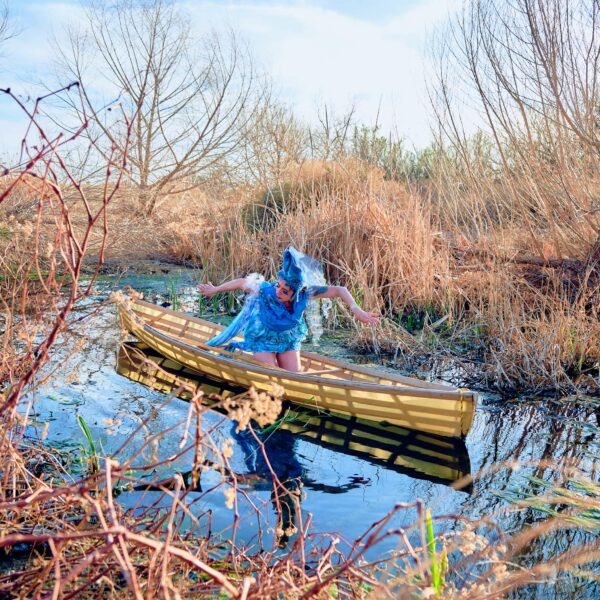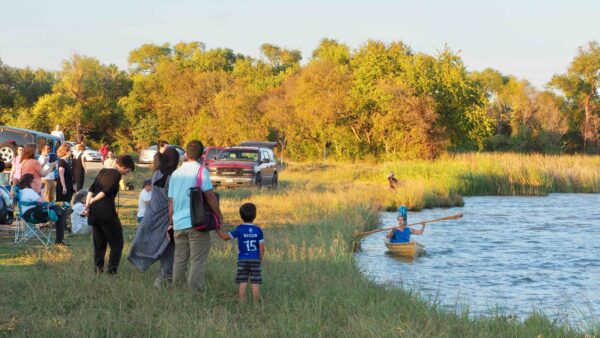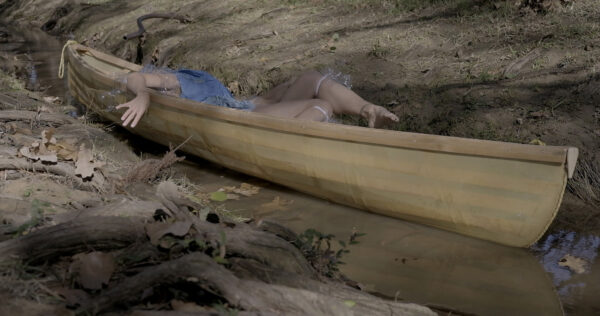
March 2022, “aqueous” performance at the Rio Bosque Wetlands in El Paso, TX. Courtesy Federico Villabla
Rosemary Candelario creates dances informed by ecology and the Japanese dance form butoh. Her side-adaptive project aqueous intends to direct attention to the sources of water around us. This includes water’s seasonal, geologic, and geographic abundance and scarcity in Texas. Candelario first performed the outdoor version aqueous in Denton, Texas on October 23, 2021. On March 24 and 26, 2022, she took the performance to the University of Texas at El Paso and Rio Bosque Wetlands Park for World Water Week. When she returned from her El Paso trip, I talked with her about her work.
Anna Adami (AA): There is an Australian aboriginal greeting, “From what water do you come?” How would you answer that greeting?
Rosemary Candelario (RC): I come from Lake Michigan. Both my parents are from Michigan, though we moved around a lot. As an adult, I also lived in Boston for a long time, then in Los Angeles.
AA: 10 years ago, you moved to Texas. How did this move affect your creative work?
RC: When you live near water, there’s a certain gravity to it. You can feel it. When I lived in Boston, I lived probably five miles away from the ocean. I didn’t often see it, but could still smell it and feel it in the air. It affects the weather and the growing seasons.
In North Texas, I can’t feel that. Even in Houston, the bayou water feels so full of the oil industry. I haven’t been to Galveston, but it feels so far away. I can’t feel the Gulf in my body. Geologically, the ocean used to be here. But now, most of the bodies of water in Texas are man-made. Or seasonal creeks. It’s made me interested in finding the water and thinking about its source. All things related to water become more important here.
It’s also a useful thing for humans to feel beyond our time.
AA: Could you talk more about that?
RC: I’m really interested in the Japanese performance duo Eiko and Koma — I wrote a book about them — and they’d always say, time is not even, space is not empty.
If you’re thinking geologically or even thinking from one century to the next, you’re forced to see your own time differently, and the consequences of your actions differently. In Texas you can certainly think about the way the Civil War and Jim Crow are still active in our community. Holding the past in the present is an important way of shifting our thinking.
This is something I’m interested in dancing through. To me, if we’re going to forestall climate change or catastrophe in any meaningful way, we have to fundamentally change the way we understand ourselves and our relationship to the world.
AA: How do time and space play a part in your work around Texas waterways?
RC: We think Texas has always been like this. But when the first Europeans came to Big Bend and documented things, they talked about lush prairies. It wasn’t a desert. In a very short ecological span of time, that land was drained. We can devastate land quickly. But if we show it some care, we can also restore it quickly. I saw this at the Rio Bosque Wetlands in El Paso.
The park began a wetlands restoration in 1999. Since, they’ve seen incredible returns of vegetation, birds, and all sorts of creatures. The people who work there just light up when you ask them what’s special to them about the place. “The life; there’s life here now,” they say.
Because water in Texas has been so different geographically over time, it can teach us important lessons. I use site-adaptive work to bring the audience in and ask them to move and connect to the land in a way that they haven’t before. Those kinds of connections, even if momentary, have a lasting impact in the body. That’s the sort of deep change that I’m looking for. We must shift people at the bodily level in order for our behaviors to shift. For us to actually do the things that make sustainability for the entire planet possible.

March 2022, “aqueous” performance at the Rio Bosque Wetlands in El Paso, TX. Courtesy Federico Villalba
AA: Do you think sustainability efforts should start at the body level of the individual instead of going straight to something like policy?
RC: I think you need both. Policy can lead human behavior, but it’s not really going to shift people’s relationships. You also need physical commitment.
When I first started making this work, I started hearing from audience members. “Oh, my body felt so different after the performance.” “Wow, I felt calm in my body for days afterward.”
I’ve realized that bringing audience members or witnesses to the space for a set amount of time and having them breathe and move at the pace of my movement is impactful. In my work, I’m not the art object. I’m the facilitator of the concentrated experience.
AA: Would you say you’re inviting people into a meditative experience?
RC: It’s interesting — I used to resist that kind of feedback or observation.
In one workshop, I had people moving for a while. Near the end, I said, “Be drawn to a non-human partner. The first step is to ask permission if you can dance with them.”
I could tell a lot of people were wary. But then they reported things like, “It said no, I’m going to find another one.”
One person said, “I asked the tree for permission to dance and it said okay, but don’t hurt me.”
The next step was just to try to breathe with the non-human partner, at their pace. So how does a rock breathe? Or that bench breathe? Try to shift your blood flow to its internal flow.
Afterward, one person told me, “I have a meditation practice, but I often get distracted from the breath. Breathing with nature like this, I never got distracted.”
What I’m seeking is a kind of openness. An opening of the skin. Donna Haraway famously wrote in the 80s, “Why should our bodies end at the skin?”
In fact, what I’m asking for is a type of attunement or attention, which is really what mindfulness is. Meditation often involves de-centering the self and connecting. It was an interesting shift for me — I shouldn’t just dismiss it when people say my work is meditative.
AA: In other words, your entry point for connection didn’t necessarily come out of meditative schools of thought. It sounds like your entry point has come more so out of your dance education, is that right?
RC: Yeah, it’s a lot from teachers I’ve had. Certainly, when I wrote my book about Eiko and Komo, I spent a lot of time with them. I took a lot of their workshops. Now I feel like much of how I approach the world comes from them. Their approach to working in and with nature became a part of me.
I once heard someone ask the pianist Margaret Leng Tan, “what’s it like to be playing the piano while Eiko and Komo are dancing with this tree?” And she said, “The piano remembers being a tree.”
We could dance with this table we’re sitting at. And even these benches.
AA: They’re all made with materials from the Earth.
RC: Yeah, it’s coming from somewhere. So how can we connect with that? And understand that, like this table or this floor, we’re just a part. Even concrete is made of minerals from Earth. It might be harder to recognize as Earth, but it is. It’s more about how we recognize ourselves as part of, with, alongside instead of in or on.
In her workshops, Eiko works a lot with images of water. And she would say, “Do a dance in your shower with the water and feeling the water.”

October 2021, “aqueous” performance at North Lakes Retention Pond in Denton, TX. Courtesy Brian O’Connor
AA: How would you describe the experience of dancing and responding to something — be it this table or the shower water?
RC: There is something in my process that I call a camouflage or an octopus score — named after the way an octopus can become what’s around it. Dancing that way is a part of my practice of getting to know a place.
In aqueous, I’ll be in the boat long before the audience arrives. Part of my experience then is just sitting and noticing. Noticing the bullfrogs or dragonflies. I start to bring their energy in. I notice if I shift my energy and my attention, then the animals around will also respond in kind. So if the ducks, who aren’t used to my energy, start following me, I can start to follow them. We can have a little dance. Or I can respond to a flock of birds flying by. And if I’m responding with my body, then it takes the audience to them as well.
In some ways, it feels like a stilling. And an opening. Then responsiveness. In butoh practices, slowness is used to shift us out of the habitual. There’s a particular rhythm of life that we’re used to. Things like slowing the breath, slowing the walk, or trying to come into rhythm with the environment allow me to notice the movement that’s already happening. On the one hand, it’s simple, but it can be a profound practice.
AA: Because I feel like simplicity isn’t the norm. The world we live in is busy and chaotic, so slowness doesn’t always come easy. When it’s experienced, it often is something unique and profound.
RC: And it takes effort. I know a lot of times dance students are so surprised. They’re used to moving with speed and momentum and flow, which in some ways takes less muscular effort. Walking slowly may take more. After practicing in my workshops, dancers are often like, “Oh my gosh, I’m so tired. I can feel all my muscles.” We’re used to go, go, go, and then collapse.
Butoh originally emerged as part of the avant-garde movement in Japan. It was about rejecting societal norms, saying, no, we don’t want to be the human you’re training us to be in school or in the military. I feel like, in today’s world, openness and connection is taboo. More of the norm is, you’ve got to be out there for yourself. In response to those norms, my practice is a very radical thing.
AA: You first performed aqueous in North Texas, and just recently you took it to El Paso. Since aqueous is site-specific, how did the performance change?
RC: Because the sites were so different, the performances called attention to different things. At the retention pond in Denton, I intended to bring attention to a body of water that people might not necessarily know about. Whereas in El Paso, my intention was to bring audience members’ attention to the presence and absence of water. I was walking a lot more in the El Paso performance. I started in the water of a river channel, then ended in the dry.
The absence of water in El Paso is tied in with the presence of the border. Since the border wall has gone up, it’s also cut off the connectivity of the wetlands, particularly for land creatures. There had been a channel going along the border for irrigation. Then they poured concrete. The concrete takes away some of the connectivity.
But while there’s the absence of water, there’s also its precious presence. While we can’t always see the water, we can see the effects of its presence.

Still from the dance film of “aqueous,” which premiered at the Greater Denton Arts Council on December 9, 2021. Courtesy Tara Baker
AA: How would you describe the use of collaboration in aqueous?
RC: In the past, a lot of my outdoor work has been group work. So aqueous is very different in the sense that I am the one dancing body. But it’s still very collaborative in terms of how it’s made. First of all, if you just look at the performance, the boat is a partner. And the environment is a partner as well. When I did this piece in October, the winds were quite high. The wind was a partner. The water. It was not just me dancing there.
But also, Sarah Ruth, the musician, is key. She’s from the panhandle and grew up on a farm, so she has a particular experience of dryness and what water means there. She and I have had several experiences working together where it feels, without planning, like I move in some way and her voice is coming from my body.
And Irene Klaver, professor of environmental philosophy at the University of North Texas — she does a lot of work around the meanings of water. The first time I went to her house, I saw one of her partner’s, Brian O’Connor’s, boats. It took years for me to ask him to make a boat for me. I wouldn’t do it without funding. I had an opportunity for funding from TWU’s Department of Dance, so he became very much a partner in that.
Then for the costume — I had seen one of Rachel Hudson’s dresses made for the Old Scraps Trashion show. I contacted her after that. She had her own process of incorporating water into the natural dyeing process.
Even though the collaboration of this project isn’t visible, all these components are present in the art and enable the art.
You can learn more about Rosemary Candelario’s work by visiting her website.



2 comments
Anna,
Thank you for introducing me to the magical work of Rosemary Candelario. This insightful interview brings up so many important themes–environmental sustainability, act as activism, how to engage audience in meaningful experiential dialogue about the land. As a fellow dancer and performance artist, I love what Rosemary said about the Octopus score, how to move and breathe in order to become one with our environment/surroundings.
Colette,
It was truly my pleasure! I’m glad to hear you enjoyed our discussion 🙂